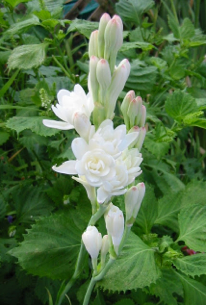Pokok Harum Sundal Malam
| Pokok Harum Sundal Malam | |
| Scientific Name | Polianthes tuberosa |
| Family | Agavaceae |
| Plant materials of interest | The flower are fragrant and used for a raw material of perfume |
| Common name | Tuberosa |
| Description | Typically found at an altitude of 0 to 3,108 m (0 to 10,197 feet). Size 18-24 “ tall |
 |
{slider=Geographical & Distribution}
Native to Mexico
{/slider}
{slider=General Appearance}
Perennial and night blooming plant. It grows in elongated spikes up to 45 cm long that produce clusters of fragrant waxy white flowers that bloom from the bottom towards the top of the spike.
{/slider}
{slider=Chemical Contituents}
Sapogenin as antipyretics and eliminate swelling. The single floweed tuberose has high essential content ranging 0.08-0.10%.
The flower volatile compounds were identified as benzyl benzoate, methyl (E)-isoeugenol, ethyl myristate, and methyl anthranilate (Mimaki Y. et al 2002).
Several steroid sapogenins, such as hecogenin, 9-dehydroxyhecogenin, and tigogenin, as well as glycosides, 29-hydroxystigmast-5-en-3β-yl β-Dglucoside,
(22S)-2β,3β,22-trihydroxycholest-5-en-16β-yl β-Dglucoside, and diribo furano-sylethyl eneglycol, and spirostanolpentaglycosides were identified from the underground parts of P. tuberosa. Our search for bioactive saponins from
P. tuberosa has led to the isolation of six new steroid glycosidess two spirostanols, polianthosides B and C (1, 2), and four furostanols, polianthosides D-G (3-6) together with eight known saponins (7-14) from the fresh tubers. (Jin J.M. et al 2004).
A few glycosides, such as (22S)-2β,3β,22- trihydroxycholest-5-en-16β-yl β-D-apiofuranoside, 29-hydroxystigmast- 5-en-3β-yl β-D-glucopyranoside, and diribofuranosyl ethyleneglycol, were isolated from the underground parts of P. tuberosa. Cholestan glycoside and three steroidal saponins isolated from the aerial parts of P. tuberosa
{/slider}
{slider=Traditional}
Rheumatoid arthritis:
30 gm root, 20 gm aplina purpurata, dark brown sugar, 400cc water, boil. Strain and 2 parts to be used twice a day.
{/slider}
{slider=Research}
Polianthes tuberosa Saponin 7
Four spirostanol saponins with five monosaccharides (1-4). The cytotoxic activities of against HL-60 human prolyelocytic leukimia cells and HSC-2 human oral sequacous cell carninoma cells (Mimaki, Y., et al., 2002).
Although the cytotoxicity of against HL-60 cells was moderate (IC50 3.9-9.0 µg/mL) compared with that of etoposide used as a positive control (IC50 0.30 µg/mL),
HSC-2 cells, which were resistant to etoposide (IC50 24.4 µg/mL), were relatively sensitive to the four spirostanol, showing IC50 values ranging between 1.5 and 13.0 µg/mL (Mimaki, Y., et al., 2002).
Modulatory effect on the murine self defense system
Modulatory effect on the murine self defense system by a newly discovered acidic polysaccharide (ANK-102) produced by P. tuberosa cells in liquid culture was examined. Pretreatment with ANK-102 deteriorated the murine survival against lethal infection of Listeria monocytogenes, an intracellular gram-positive bacterium eliminated mainly by macrophages through T-cell mediated immune response. Pretreatment with ANK-102 resulted in the accumulation of Mac 1 and Mac 2 positive cells in the peritoneal cavity of the infected animals and the reduction of Thy1.2 expression on the surface of the thymocytes. (Majima T., 1995).
Effects on snail
The powder of P. tuberosa bulb and its sapogenins tigogenin and hecogenin on the reproduction of the snail Lymnaea acuminata. It has been reported that the two sapogenins tigogenin and hecogenin caused a significant reduction in fecundity, hatchbility , and survival of young snails. Exposure to sub-lethal concentration caused a small but significant reduction in proteins, amino acids, nucleic acids and phosphtase activitites in gonadal tissue of treated sanils (Singh K et al 1999).
{/slider}
{slider=Reference}
Jin J.M., Zhang Y.J. and Yang C.R. (2004). Spirostanol and Furostanol Glycosides from the Fresh Tubers of Polianthes tuberosa. J. Nat Prod ; 67 pg 5-9.
http://nieare11.blogspot.com/2012/02/various-blossoms-polianthes-tuberosa.html
Majima T., K. Otsuji, R. Nagatomi, Konno T. (1995) Polysaccharide (ANK0102) from Polianthes tuberosa cells deterorates the resistance of mice to Listeria monocytorenes infection.http://www.researchgate.net/researcher/68170940_T_Majima/
Mimaki Y.’, A. Yokosuka, C. Sakuma, H. Sakagami and Y. Sashida, J. Nat. Prod., 65, 1424 (2002). http://download.springer.com/static/pdf/
Singh K., V.K. Singh, Singh D.K. (1999) Effect of Polianthes tuberosa (Amaryllidaceae) on the Reproduction and Biochemical Parameters in the Ovotestis of Snail Lymnaea acuminata (Mollusca, Pulmonata). Acta hydrochimica et hydrobiologica. Vol 27 (1) pg 32-37.
{/slider}
- Last updated on .
- Hits: 7821
